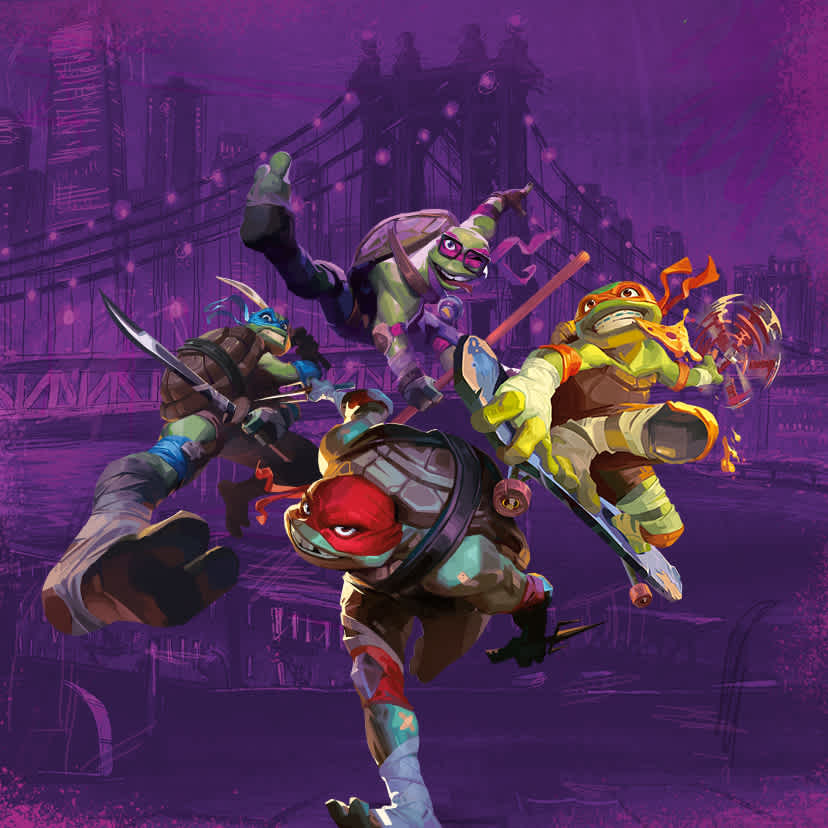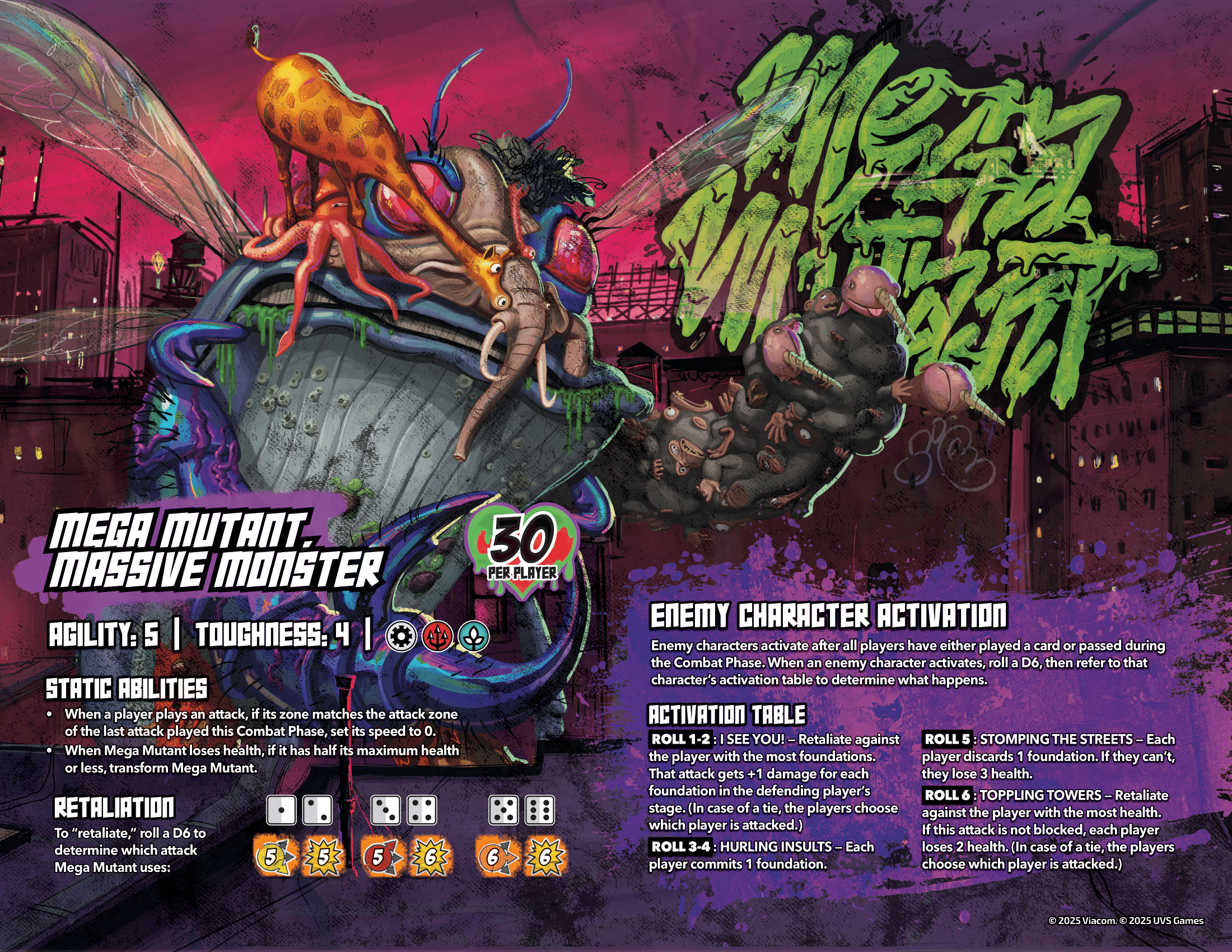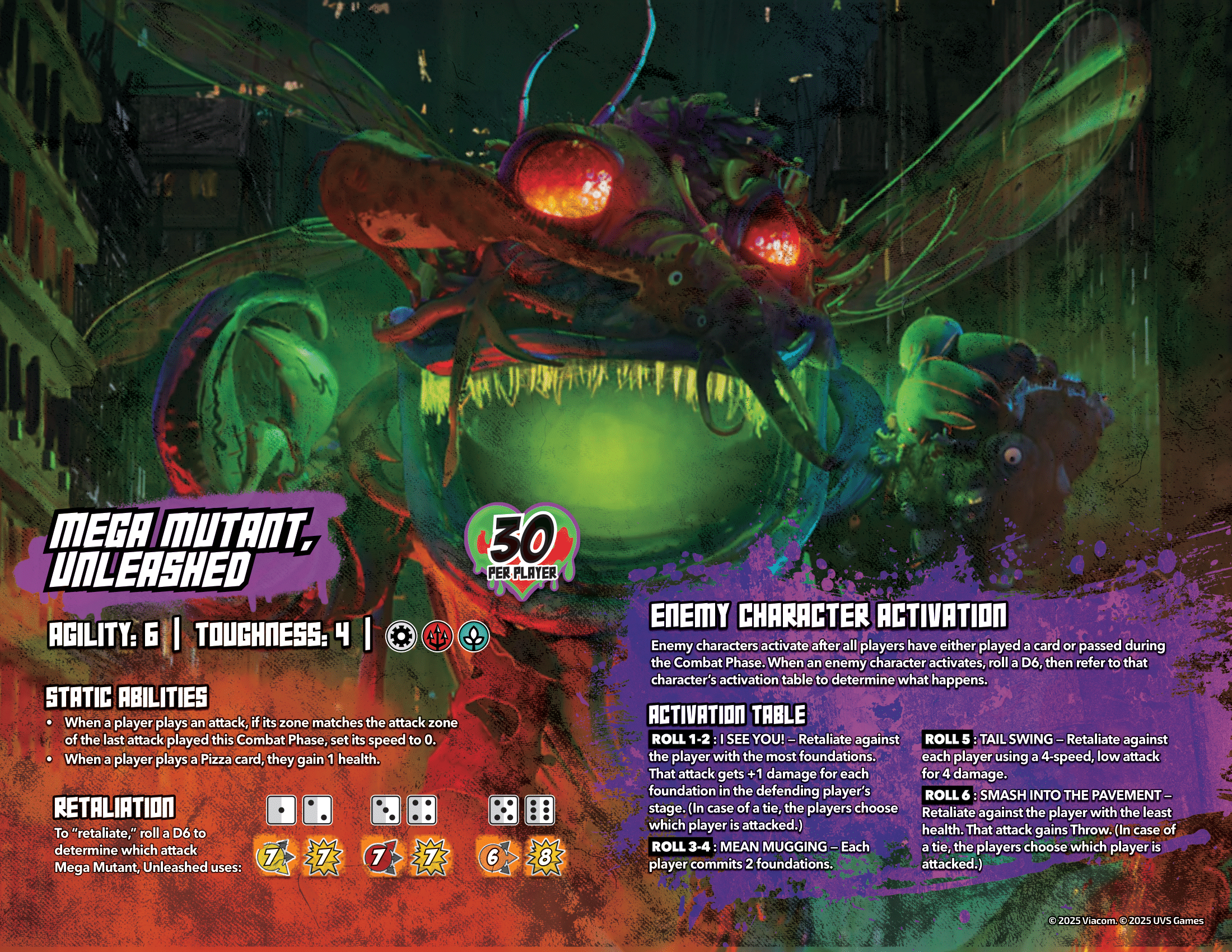

Teenage Mutant Ninja Turtles PVE Boss Battle - Mega Mutant, Unleashed
UVS Games Game Design Team
Mayhem at the Prerelease
As an accompaniment to the Teenage Mutant Ninja Turtles prerelease, we put together a new boss battle designed to challenge your sealed decks and/or starter decks during the event.
The Massive Monster of Manhattan, Mega Mutant!
Boss Battles at the Prerelease
One of the things we love about Boss Battles is the opportunity for you to bring a new player into the game in a cooperative manner. There is no awkwardness involved in reminding your buddy what to do, or even in sharing knowledge of your hand. Whether you win or lose, you do it together.
With those benefits in mind, we wanted to give stores and players the opportunity to explore our newest set in this manner.
For logistical reasons we’re hosting these as digital assets, but feel free to print them out for play.
For Event Organizers
Battles vs Mega Mutant can be a great alternative experience for players who are not are not looking for a competitive tournament experience.
As previously stated, this is a digital-only asset. You may want to consider printing out a copy for your players to enjoy. A .PDF version of the download is available at the bottom of this article.
This experience is designed for prerelease-level decks. If players wish to battle the Mega Mutant with constructed decks, you might consider increasing the difficulty by increasing the health per player of Mega Mutant or even beginning on the transformed side with full health.
For new players who aren't yet ready to build a sealed deck, encourage them to try a TMNT starter deck to battle the boss.
You can find the updated rules for running a boss battle at the bottom of this page.
New with Mega Mutant
First, this is a double-sided boss! The Mega Mutant battle is divided into two stages. When you bring the Massive Monster side down to equal to or below half his health, he will transform into an even more powerful form: Mega Mutant, Unleashed.
Cooperation is super important to defeating this opponent. Mega Mutant’s static ability encourages each player to attack in different attack zones to ensure they get past his agility and substantial toughness.
This Boss Battle is tailored to TMNT sealed decks and starter decks.
Side A:

Side B:

FAQ about this Boss
Q: What side does the Mega Mutant start the game on?
A: The Mega Mutant boss begins on the Mega Mutant, Massive Monster side. If you want an additional challenge, you might try starting on the Unleashed side.
Q: Mega Mutant’s ability to reduce speed looks for the last attack played? Does this include Mega Mutant’s retaliation?
A: Yes, after a player plays an attack directly after Mega Mutant, if they match the zone of Mega Mutant’s retaliation that attack’s speed will be reduced to 0.
Q: How do players choose who gets attacked in case of a tie?
A: This is a cooperative experience so we recommend groups collaborate to make a group choice, but if you cannot agree you might try a random method like rolling a die.
Q: Can the boss attack one of my backups instead of me if I am targeted?
A: No, Mega Mutant only attacks the players selected by its activation or targeted by a retaliation unless an effect causes the attack to be redirected to target a backup.
Q: What’s a boss? What’s an enemy?
A: The Mega Mutant is a boss, and that boss is also your enemy. During PVE experiences both of these terms are generally referring to your rival.
Q: Does the boss retaliate with the same attack against everyone?
A: When the boss retaliates against more than one player you will individually roll the die to determine which attack they use for each player, unless otherwise stated. Specifically, the "Tail Swing" ability will retaliate with a 4 speed, 4 damage low attack against everyone.
Q: Can I use the Mega Mutant character vs the Mega Mutant boss?
A: Go right ahead, there are no restrictions on what characters you use. I like to imagine the character version being eager to get rid of any pretenders.
PVE Rules
Setup
Each enemy character has a specific number of HP per player.
Each player reveals their character and shuffles their decks. Then reveals 10 cards from the top of their deck each player may build up to 3 foundations from among the 10 cards they revealed this way, then shuffle their deck.
Finally, players draw their opening hands and make mulligan decisions as if they were using the Official Player 2 mulligan rules.
General Rules
The Combat Phase is collective for all players, but each player maintains their own card pool. At the beginning of the Combat Phase, choose a player to be the first player who was not the first player during the last Combat Phase. This can be denoted any way the players see fit, most commonly with a token.
During the Combat Phase, players take turns. On their turn, a player may play 1 card, play 1 form ability, or pass. After each player has taken a turn, the enemy character activates (see Enemy Character Activation).
Note: If a player fails a check to play a card on their turn, the enemy character retaliates against them (see Retaliation on the enemy character card).
The Combat Phase continues until either no player is able to play any cards or all players choose to end the Combat Phase (and all enemy character actions have resolved).
When the Combat Phase ends, the enemy character retaliates against all players. Then players clear their card pools and begin a new collective Start Phase.
When the enemy character activates, roll a d6 and take the corresponding actions from the enemy character’s table. If an activation affects all players, begin with the first player and resolve the effect from left to right.
If a player’s card or effect asks a rival to make a choice, the player who controls the card or effect makes that choice instead. If a card or effect asks a rival to take an action they are not able to take, the player may choose the outcome most favorable to themselves.
Attacking and Blocking
Player attacks deal their damage minus the enemy character’s toughness. When the enemy character’s toughness prevents at least some damage from an attack, that attack is considered to be partially blocked.
If the speed of a player’s attack is greater than or equal to the enemy character’s agility, that attack ignores toughness.
In addition to players blocking for themselves as usual, any player may block for another player during a retaliation. The block is placed in its owner’s card pool. If a block for another player is successful, the blocking player loses 1 health and the defending player takes either no damage for a full block or half damage (rounded up) for a partial block, as usual.
In addition to playing enhance abilities during their own attacks, each player may play up to 1 enhance ability during each other player’s attack.
Advanced Rules
You may elect to play with any of these optional advanced rules.
The enemy character’s attacks are considered to have the same resource symbols as the enemy character.
If a player plays a Stun ability, the enemy character loses health equal to its Stun rating.
Enemy Character Activation
Boss characters activate after all players have either played a card or passed during the Combat Phase. When the boss character activates, roll a d6, then refer to that character’s activation table below to determine what happens.
Retaliation
The Boss may retaliate against one or more players during game play. The Boss retaliates against a player or players when:
A player’s attack deals 10 or more damage to them.
When a card or effect instructs them to.
When a player fails a check to play a card during their turn.
To “retaliate,” roll a d6. The player being retaliated against defends against the matching attack listed on the front of the enemy's card.
